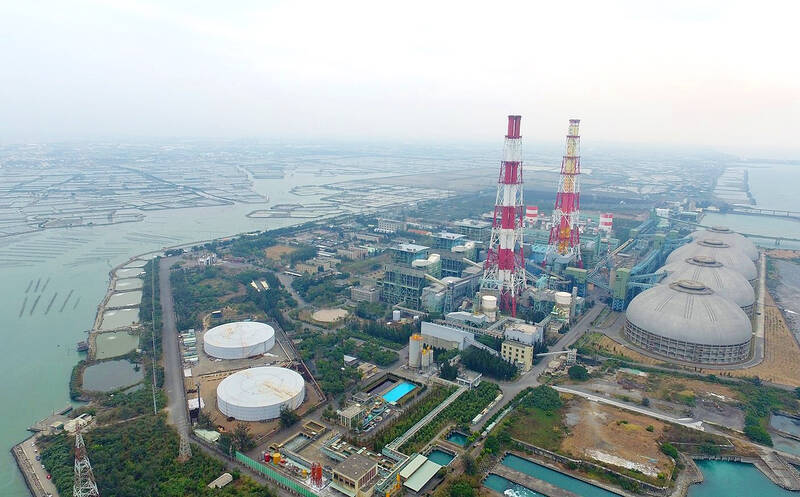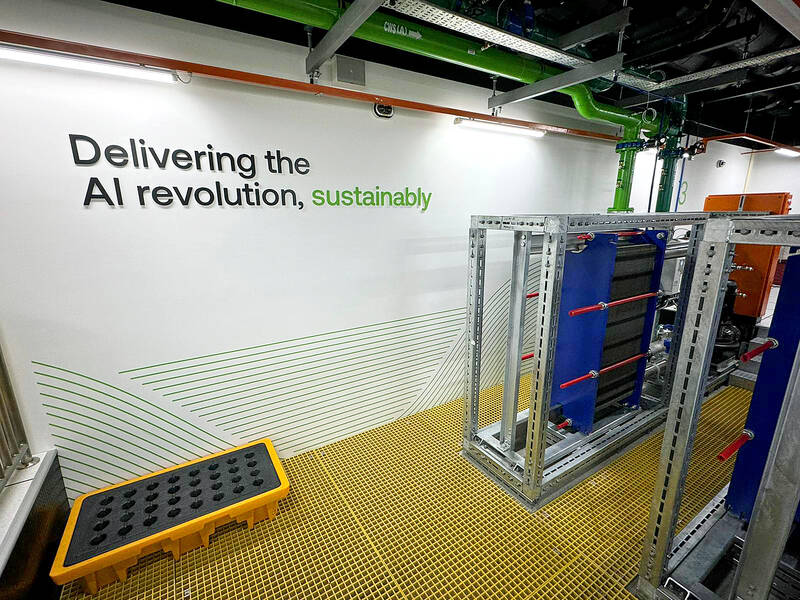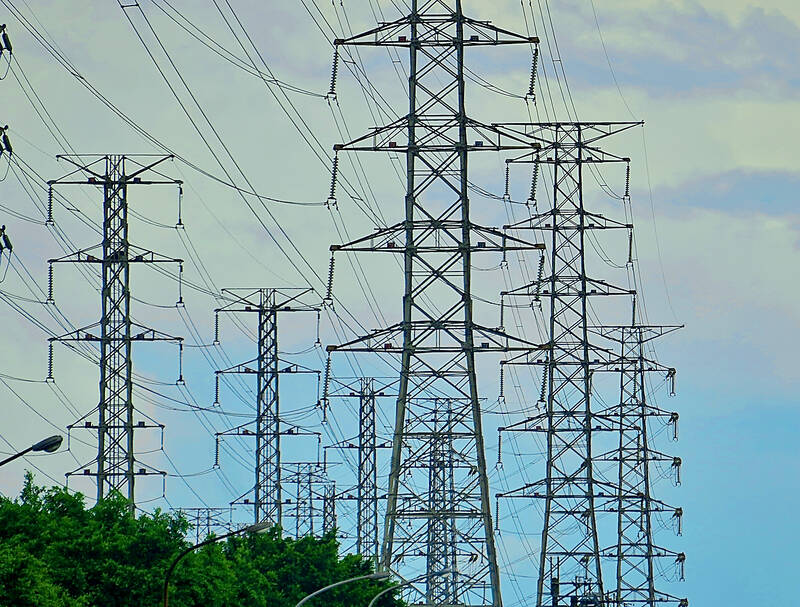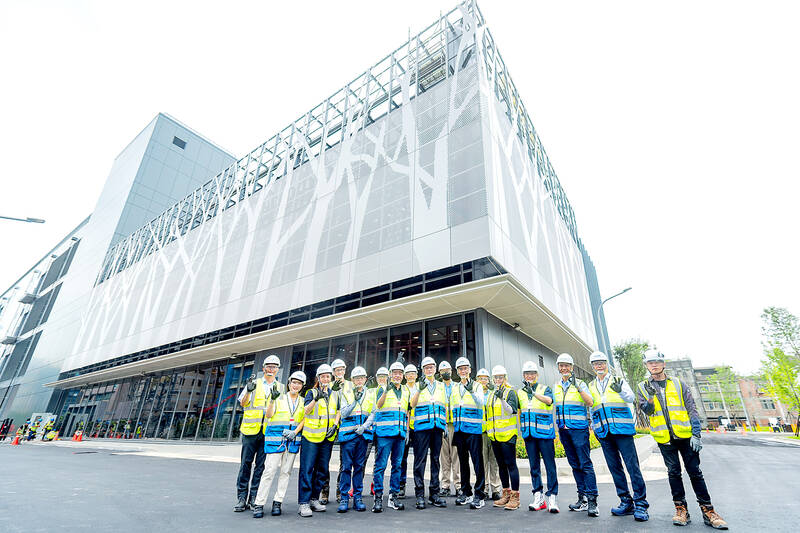President William Lai’s (賴清德) vision for Taiwan to become an “AI island” has three conditions: constructing advanced data centers, ensuring a stable and green energy supply, and cultivating AI talent. However, the energy issue supply is the greatest challenge.
To clarify, let’s reframe the problem in terms of the Olympics. Given Taiwan’s OEM (original equipment manufacturer) roles in the technology sector, Taiwan is not an athlete in the AI Olympics, or even a trainer, but rather a training ground for global AI athletes (AI companies).
In other words, Taiwan’s semiconductor ecosystem provides world-class training facilities and equipment that have already attracted top AI athletes like Google, Microsoft, Amazon, Nvidia and AMD. But for these athletes to train effectively, Taiwan also needs to provide a proper diet to literally power them. They need a balanced diet of quality electricity that Taiwan may not be able to provide.

Photo courtesy of Citizen of the Earth, Taiwan
AI IS POWER HUNGRY
AI systems are like elite athletes with insatiable appetites. Training AI models, particularly complex ones like large language models, requires immense computational power, which in turn requires vast amounts of electricity.
For example, Nvidia’s H100 GPU — a chip that performs around four quadrillion calculations per second — consumes about 700 watts under full load, roughly equivalent to the power usage of an average US household occupant. A data center typically uses 10,000 to 100,000 GPUs. The new Vantage 16MW Data center in Taipei probably has about 20,000 GPUS, and when running 24/7, this smaller data center will consume the power of a small town of 13,000 households.

Photo: CNA
Complex AI models, like large language models, require an incredible amount of computation power and electricity. It has been estimated that in 2020, OpenAI trained its 175-billion parameter GPT3 model on 10,000 Nvidia V100 GPUS over a few months at a cost of around US$4.6 million.
TAIWAN (INDUSTRY) IS POWER HUNGRY
Taiwan is already a power-hungry island. With a population of 23.42 million, the country consumed 276.52 terawatt-hours (TWh) of electricity in 2022, translating to 11,807 kilowatt-hours (kWh) per capita. This is close to the US consumption of 12,702 kWh per capita and significantly higher than Japan’s 7,799 kWh. This high per-capita usage is due to Taiwan’s industrial sector that consumes about 56 percent of Taiwan’s power. TSMC alone consumed 25 TWh last year, which is 9.04 percent of Taiwan’s total power consumption. Greenpeace projects that TSMC will consume 74 TWh by 2030, which is how much energy New Zealand consumed in 2021.

Photo: CNA
Taiwan’s expanding IT and AI industries will increase energy demand by 13 percent by 2030, though Yeh Tsung-kuang (葉宗洸) of the Institute of Nuclear Engineering and Science at National Tsing Hua University challenges this government projection and suggests that a more reasonable estimate is 15 percent growth by 2028.
So, what would a healthy power diet look like?
“To make Taiwan the Silicon Valley of Asia,” Minister of Economic Affairs (MOEA) JW Kuo (郭智輝) recently said, “we need a stable power supply, reasonable electricity prices, and adequate green electricity for companies.”

Photo: CNA
This power diet sounds very aspirational given Taiwan’s unstable power supply, unsustainable pricing, and inadequate progress in green energy development.
TAIWAN’S POWER DIET IS UNHEALTHY
Last year, Taiwan’s power generation was primarily thermal at 83.09 percent (coal 42.2 percent, liquid natural gas (LNG) 39.5 percent, and oil 1.34 percent), nuclear at 6.3 percent, and renewable at 9.5 percent (solar, wind, hydro, and biomass), according to the MOEA.

Photo: CNA
Taiwan’s power supply is inherently unstable. Since more than 96 percent of Taiwan’s energy is imported, its power supply is vulnerable to global market fluctuations and geopolitical risks. Outdated equipment and an overstressed power grid already prompt calls for both citizens and industry to reduce electricity consumption during peak times in the summer. And let’s not forget the power failures. In 2021, a failure at the Hsinta coal-fired power plant caused a massive blackout affecting TSMC and 6.2 million households. Another outage in 2022 disrupted power for over 5 million households.
The excessive reliance on imported coal and gas also puts the island at risk. In the worst case scenario of a naval blockade, Taiwan would have enough LNG reserves to last eight days in the summer and enough coal for about six weeks, according to Taiwan energy and climate specialist Angelica Oung (翁華志).
Taiwan’s electricity is unsustainably priced. The government heavily subsidizes energy costs to keep prices low, but this strategy is becoming increasingly unsustainable especially given the soaring oil and gas prices since Russia invaded the Ukraine. In 2022, for example, Taipower suffered losses of US$8.39 billion and last year US$6.26 billion, even after receiving a US$1.57 billion government subsidy.
Finally, Taiwan green energy development is lagging far behind projections. Despite ambitious goals to increase renewable energy to 20 percent of the energy mix by 2025, the actual contribution of renewables last year was only 9.5 percent. Infrastructure delays, regulatory hurdles, and the intermittent nature of renewable sources like solar and wind have slowed progress. Meanwhile, the phasing-out of nuclear power by next year will further exacerbate the situation because Taiwan will need to import even more fossil fuels like LNG, which will boost carbon emissions.
Currently, Taiwan is offering a junk food diet.
IMPROVING THE POWER DIET
For Taiwan to become an AI hub, the energy issue needs to be practically addressed. Some industry leaders, like Pegatron Corp chairman Tung Tzu-hsien (童子賢), suggest a healthier, more realistic and balanced diet of 30 percent renewable energy and 30 percent nuclear power to reduce Taiwan’s dependence on fossil fuels.
But the ruling Democratic Progressive Party has made a “no-nuclear homeland” a non-negotiable ideological principle, even if it means using more subsidized fossil fuels that generate more Taipower debt, more national security risk, and more pollution. Even Sam Kimmins of the Climate Group RE100 noted at a recent Taipei climate meeting, “We would rather that economies, given the choice, would retire their fossil fuel plant rather than their nuclear plant.”
If Taiwan continues to offer a junk food power diet, it risks losing its competitive edge in the global AI Olympics. The government needs understand and resolve the trade-offs to its green energy initiatives, reconsider its energy mix, and build a more resilient and updated power infrastructure that can support its power-hungry AI future.
Only by offering a healthier power diet can Taiwan truly fulfill its potential as the premier AI training ground and retain the world’s top AI athletes. Only then will it sustainably become an “AI island.”

That US assistance was a model for Taiwan’s spectacular development success was early recognized by policymakers and analysts. In a report to the US Congress for the fiscal year 1962, former President John F. Kennedy noted Taiwan’s “rapid economic growth,” was “producing a substantial net gain in living.” Kennedy had a stake in Taiwan’s achievements and the US’ official development assistance (ODA) in general: In September 1961, his entreaty to make the 1960s a “decade of development,” and an accompanying proposal for dedicated legislation to this end, had been formalized by congressional passage of the Foreign Assistance Act. Two

Despite the intense sunshine, we were hardly breaking a sweat as we cruised along the flat, dedicated bike lane, well protected from the heat by a canopy of trees. The electric assist on the bikes likely made a difference, too. Far removed from the bustle and noise of the Taichung traffic, we admired the serene rural scenery, making our way over rivers, alongside rice paddies and through pear orchards. Our route for the day covered two bike paths that connect in Fengyuan District (豐原) and are best done together. The Hou-Feng Bike Path (后豐鐵馬道) runs southward from Houli District (后里) while the

March 31 to April 6 On May 13, 1950, National Taiwan University Hospital otolaryngologist Su You-peng (蘇友鵬) was summoned to the director’s office. He thought someone had complained about him practicing the violin at night, but when he entered the room, he knew something was terribly wrong. He saw several burly men who appeared to be government secret agents, and three other resident doctors: internist Hsu Chiang (許強), dermatologist Hu Pao-chen (胡寶珍) and ophthalmologist Hu Hsin-lin (胡鑫麟). They were handcuffed, herded onto two jeeps and taken to the Secrecy Bureau (保密局) for questioning. Su was still in his doctor’s robes at

Mirror mirror on the wall, what’s the fairest Disney live-action remake of them all? Wait, mirror. Hold on a second. Maybe choosing from the likes of Alice in Wonderland (2010), Mulan (2020) and The Lion King (2019) isn’t such a good idea. Mirror, on second thought, what’s on Netflix? Even the most devoted fans would have to acknowledge that these have not been the most illustrious illustrations of Disney magic. At their best (Pete’s Dragon? Cinderella?) they breathe life into old classics that could use a little updating. At their worst, well, blue Will Smith. Given the rapacious rate of remakes in modern